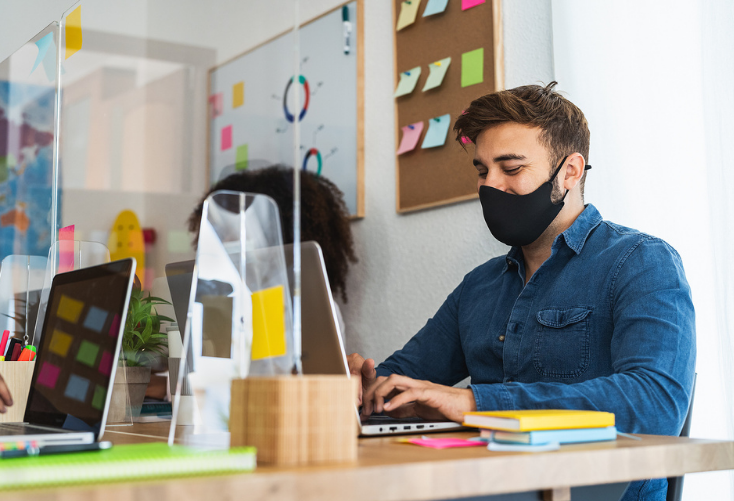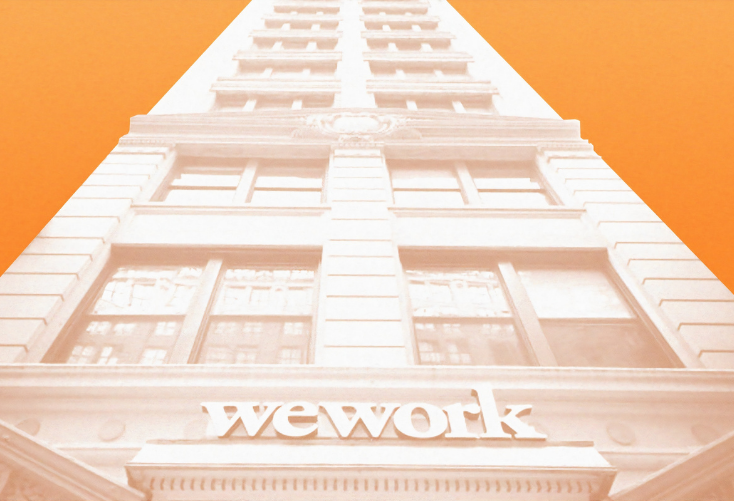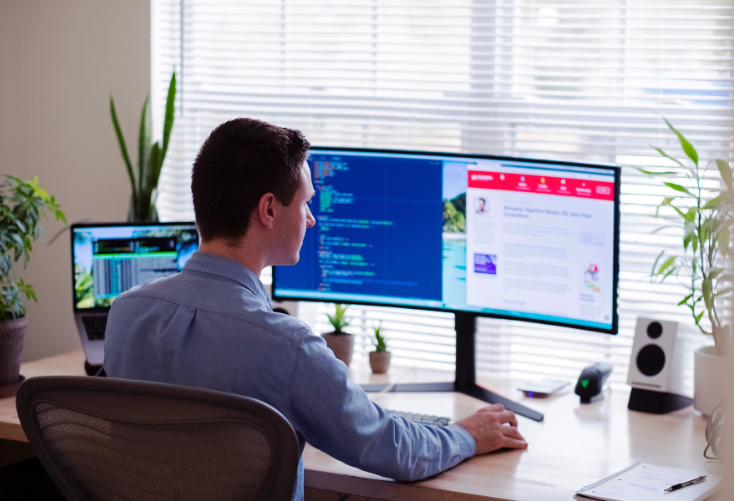Hand selected flexible workspace news from the most reliable sources to keep you ahead of the pack. We find all the latest news, so you don’t have to. Morning and afternoon updates. Stay in the know.
Here’s what you need to know today:
- What A Well-designed Office Can Do For Businesses NEW
- Supporting Remote Workers Who Are Fatigued NEW
- WeWork Continues To Burn Through Cash NEW
- Identifying Business Email Compromise Attacks
- Remote Workers Flock To Smaller Towns
- Could Remote Workers Be Taxed In The Future?
What A Well-designed Office Can Do For Businesses
Research has proven that neutral-colored offices and isolating cubicles have hindered the potential of employees in the workplace, which has led to companies completely transforming the way they design their spaces.
However, these changes mean more than improving the office aesthetic. For instance, Capital One’s annual Work Environment Survey has revealed that employees perform better and experience improved well-being when working in a well-designed office.
So how can business leaders make this change in a way that is not only pleasing to the eye, but also has a positive impact on the company’s operations?
First and foremost, the safety and health of employees should be top priority, especially in the era of COVID-19. This means implementing frequent sanitation practices, installing HVAC systems to circulate air, as well as touchless technology that can minimize the risk of spreading any virus.
This also means supporting the wellbeing of employees, particularly as mental health issues have spiked since the start of the pandemic.
Additionally, leaders need to make sure there are areas that support all employees’ work styles. This should include private areas with calm color tones for individual, focused work, as well as social areas that feature furniture that can be reconfigured easily for impromptu brainstorming sessions or collaboration.
“You have to have the right zones and layouts so that users can move intuitively throughout the space,” said Ginny Johnston, manager of workplace strategy at Capital One. “It’s a more humanistic approach to workplace design.”

Supporting Remote Workers Who Are Fatigued
A new survey conducted by Resilience First has revealed that over half of remote workers are experiencing remote working fatigue. With countries around the world entering second and third waves of the ongoing pandemic, this condition could linger on for much longer.
While some experts have argued that this means the traditional office is obsolete, others believe they can work in tandem with remote working policies. However, returning to the workplace has become a slower process than anticipated.
This has led many companies to make the permanent shift to flexible work policies that allow a combination of both in-office and remote working. Now, those who were once apprehensive about adopting remote working have accepted the reality that this arrangement will be a necessary part of the workforce moving forward.
In collaboration with law firm Russell-Cooke, Resilience First published its “Resilience and Flexible Working – The Ups and Downs” guide that contains advice on how employers can maintain trust, engagement and morale for their employees while navigating these unprecedented times.
“As a health and safety lawyer I know that many businesses are simply not aware of their duties towards their employees and the sanctions for non-compliance,” said Kizzy Augustin, partner and health and safety specialist at Russell-Cooke. “It is important that we protect our employees both from the physical health issues that are uppermost in our minds (contracting Covid-19) and also the mental health issues that may arise as a result of prolonged working from home or changes to the usual working arrangements. We hope this guide will have wide relevance and broad buy-in.”

WeWork Continues To Burn Through Cash
Coworking firm WeWork has reportedly burned through $517 million during the third quarter of 2020 as it struggles to stay afloat throughout the pandemic.
Now, the company’s cash reserves and commitments from SoftBank are at $3.6 billion, a dip from $4.1 billion at the beginning of the third quarter.
The pandemic has ravaged through the coworking and shared office industry in general, leaving operators to explore new ways to offer their services.
However, cash-burning is not new to WeWork in particular. For instance, the company also burned through $1.25 billion in the third quarter of 2019 long before a once-in-a-lifetime global pandemic.
Burning through cash is one of the main reasons Fitch Ratings downgraded the company recently, stating that the firm could burn through all of its cash by the end of 2022.
Despite these losses, CEO Sandeep Mathrani is confident the company will become profitable by 2021, citing the firm’s improvements in areas like China, South Korea and Singapore where the virus has been better controlled.
Mathrani has helped the company completely restructure its operations by renegotiating leases, laying off staffers and selling off companies that are not related to the firm’s core business.

Identifying Business Email Compromise Attacks
Business email compromise attacks target companies, rather than individuals, and appear to come from a colleague the person already knows. It can range from asking the victim to pay a new supplier, or paying an invoice for a staff member.
These sophisticated attacks are similar to other phishing emails in that they are impersonating someone else to gain data or money from the victim. However, the scammer puts in extra effort to be convincing in these instances.
Another significant difference between BEC scams and traditional phishing emails is that the latter are easier to identify. They feature spelling errors, noticeably fake email addresses and unknown senders.
BEC scammers take the time to research the company they wish to target, usually using social media sites to gain access to personal and work-related information. This allows them to easily mimic the way company employees communicate online.
Then, the scammer will buy a domain that is close to the company they are targeting with slight variations that may not be noticeable at first, such as adding an extra letter.
So how can business leaders keep their company safe from these attacks? For starters, having an email authentication protocol, such as domain-based message authentication, reporting, and conformance (DMARC), can make it easier for BEC scams to be sorted under spam folders automatically.
Additionally, educating employees on the dangers of BEC attacks, how to identify them and what to do if they are targeted through cybersecurity training is essential to protecting your company.

Remote Workers Flock To Smaller Towns
Over the last few years, Burlington, Vermont has become a safe haven for the invisible economy of remote workers who have escaped the luxurious campuses of their technology employers.
Other cities that have seen an uptick in new arrivals over the last year include Santa Barbara, California, which saw people coming from Los Angeles; Louisville, Kentucky, and Buffalo, New York, which drew people from New York City; and Burlington, Vermont which mostly saw workers migrating from Boston.
According to a survey from the University of Vermont’s Center for Research on Vermont and the Vermont Futures Project, a third of those who moved to Vermont said they are likely or very likely to stay for good.
There are numerous reasons for this massive migration to smaller areas, but one of the more significant factors is cost. Lockdowns in cities such as San Francisco and Seattle have allowed workers to contemplate whether they were being paid enough for the area they live in.
Additionally, smaller cities allow remote workers to live in a relaxed area, while still being immersed in a vibrant culture.
However, in order to support such a large amount of new migrants from large cities, these towns are seeing their own uptick in housing prices.
“As you have this influx of new, higher-starting-income jobs, you get this crowding out effect,” said Jordan Nickerson, visiting professor of finance at MIT’s Sloan School of Management. “So gentrification speeds up. People who were living there can’t afford to buy a place, so you do see displacement, and that’s a very sensitive subject.”

Could Remote Workers Be Taxed In The Future?
Deutsche Bank’s financial journal recently published a piece that advocated for an increased tax on remote workers, particularly those who continue working remotely after the pandemic has ended.
According to Luke Templeman, the author of the piece, remote workers are saving on costs due to a lack of commute and more, which would be evened out with the tax. Additionally, he indicates that since remote workers do not contribute much to local economies, this puts them on an even playing field with their in-person counterparts.
While there is no direct evidence that supports this claim, Templeman’s position is right in that the amount of remote workers will likely increase in the next few years.
The paper specifically suggests a 5% tax every day that an employee works remotely, which Templeman says is equal to how much someone would spend on work-related expenses during an in-office day.
However, the tax would have certain exemptions in terms of when it is implemented and who it impacts. For instance, it would only apply to people working from home when it is a viable option. So if employees are being forced to work from home during a pandemic, the tax would not be imposed.
Still, employees that have started working remotely over the past several months have reported increased expenses for electricity, internet connection and home office supplies.
Overall, while Templeman understands that this suggestion is not an overall solution, it has undoubtedly sparked a debate about how remote working could look in the coming years.



 Dr. Gleb Tsipursky – The Office Whisperer
Dr. Gleb Tsipursky – The Office Whisperer Nirit Cohen – WorkFutures
Nirit Cohen – WorkFutures Angela Howard – Culture Expert
Angela Howard – Culture Expert Drew Jones – Design & Innovation
Drew Jones – Design & Innovation Jonathan Price – CRE & Flex Expert
Jonathan Price – CRE & Flex Expert














